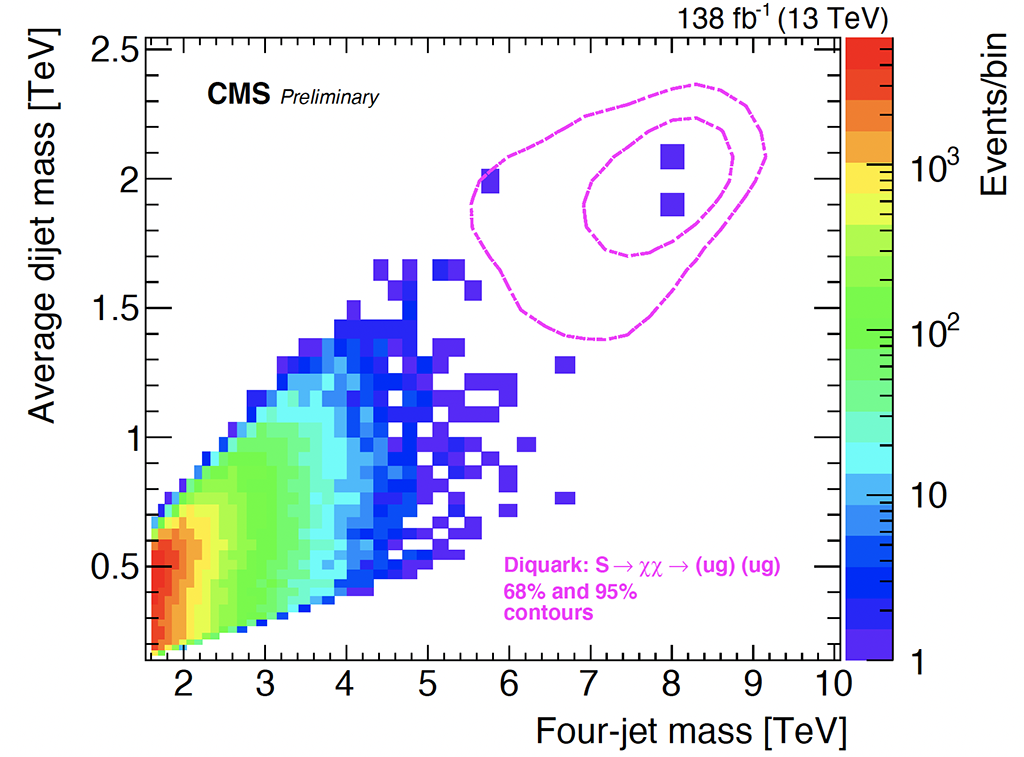With Run 3 of the LHC just around the corner, the LHC experiments are still publishing new results based on the previous runs' data. Despite no new discoveries being announced, small deviations from expectations are appearing in a small number of analyses. At the current level these deviations can still be attributed to random fluctuations in data, but they indicate regions that need to be investigated closely once the new stream of collisions arrives. Below are a few examples published recently by the CMS collaboration.
In 2017 CMS recorded a spectacular collision event containing four particle jets in the final state. The invariant mass of all four jets was 8 TeV and the jets could be divided into two pairs with a 1.9 TeV invariant mass each. Such a configuration could be produced if a new particle with an 8 TeV mass was created in the collision of proton beams, and subsequently decayed into a pair of - again, new - particles, with masses of 1.9 TeV. In a new analysis recently published by CMS, a search for such twin pairs of jets with matching invariant masses is performed for data collected up to the end of LHC Run 2. Surprisingly, a second event with similarly striking properties was found, with a 4-jet mass of 8.6 TeV and 2-jet masses of 2.15 TeV. These two events can be clearly seen in the plot below, where the 4-jet events are plotted as a function of the 2-jet and 4-jet mass.

While nearly all observed events with two pairs of jets are produced by strong interactions between the colliding photons, events with such high invariant masses are extremely unlikely. The probability of seeing two events at these masses without any new phenomena being present is of the order of 1 in 20 000, corresponding to a local significance of 3.9σ. While this may appear to be a very strong signal at first, given that the area of masses that are being analysed is large it is important to also look at global significance, which indicates the probability of observing an excess anywhere in the analysed region. For the two events the global significance is only 1.6σ.
Two other searches for new heavy particles are reporting small excesses in data. In a search for high mass resonances decaying into a pair of W bosons (that then decay into leptons) the highest deviation corresponds to a signal hypothesis with a mass of 650 GeV, with local significance at 3.8σ and global significance of 2.6σ. In a search for heavy particles decaying into a pair of bosons (WW, WZ or other combinations, also including Higgs bosons) that subsequently decay into pairs of jets, the data diverge from expectations in two places. The signal hypothesis is a W' boson with a mass of 2.1 or 2.9 TeV, decaying into a WZ pair and the highest local significance is 3.6σ, with a global significance of 2.3σ.
Another new result comes from searches looking for extra Higgs boson particles decaying into tau pairs. For a new particle with a 100 GeV mass there is a small excess seen in the data with 3.1σ local and 2.7σ global significance. Interestingly, this coincides with a similar excess seen by CMS in a previous search for low-mass resonances in the two-photon final state. Another excess is visible in the high-mass range, with the largest deviation from the expectation observed for a mass of 1.2 TeV with a local (global) significance of 2.8σ (2.4σ).
The tau pair final state was also used to look for hypothetical new particles called leptoquarks. This is of particular interest since leptoquarks could potentially explain the flavour anomalies that have been observed by the LHCb experiment, so if the anomalies are indeed a manifestation of some new phenomena, this would be a way to independently look at these phenomena from a different angle. No excess has been found by CMS so far, but the analysis is only just beginning to be sensitive to the range of leptoquark parameters that could fit the flavour anomalies, so more data is needed to fully explore the leptoquark hypothesis.
The new LHC data-taking period is set to start in July, at higher energy and with significantly upgraded detectors, promising a fresh stream of data for searches for new phenomena.







